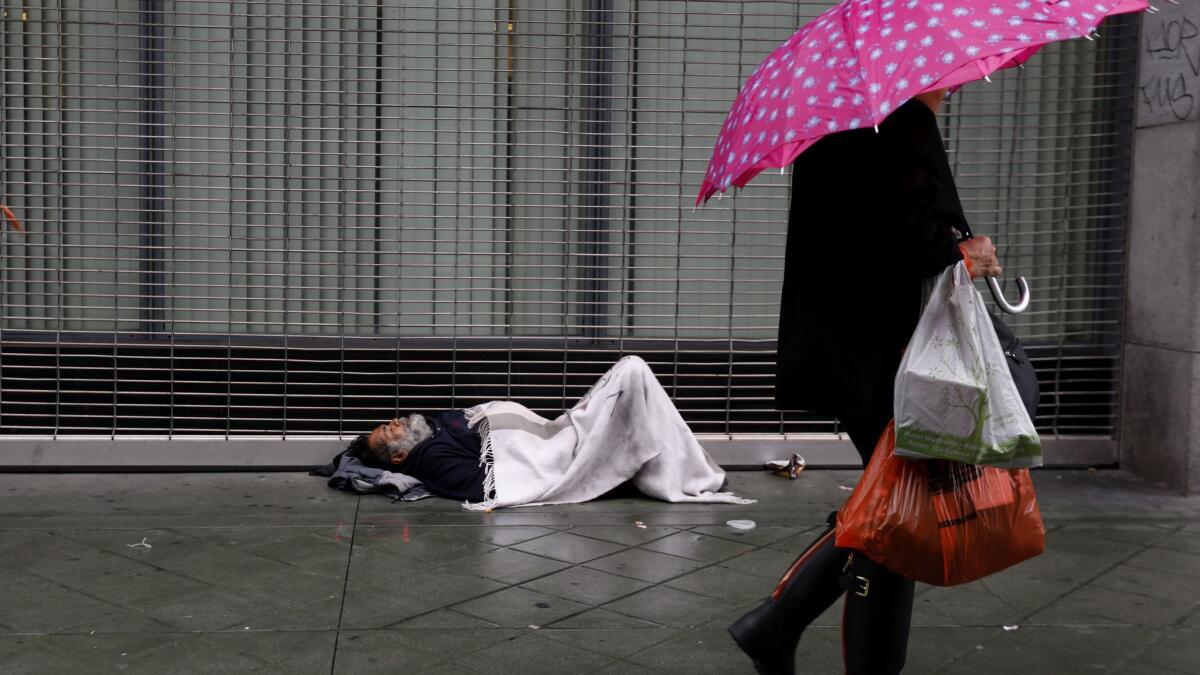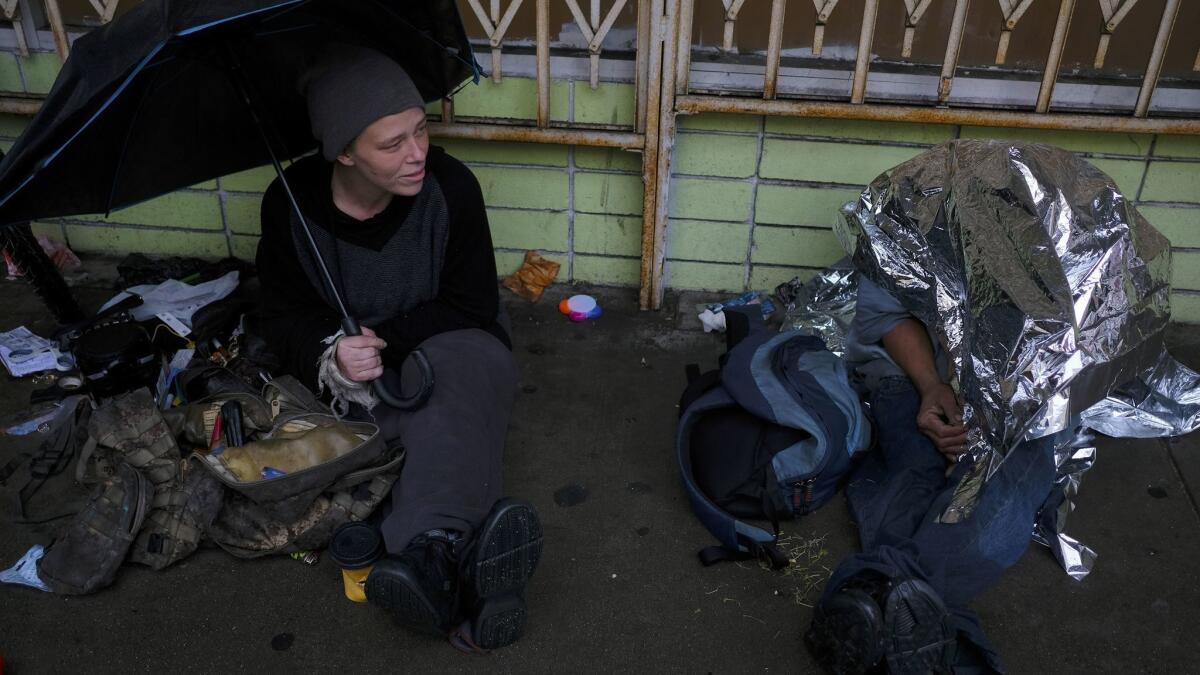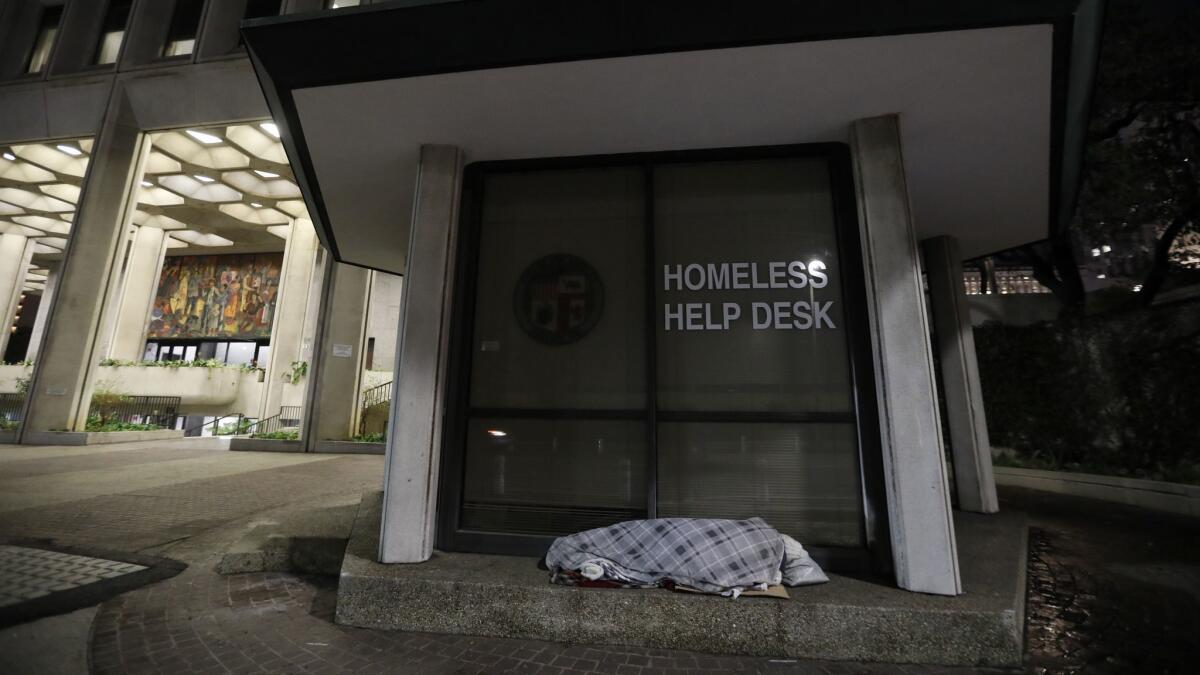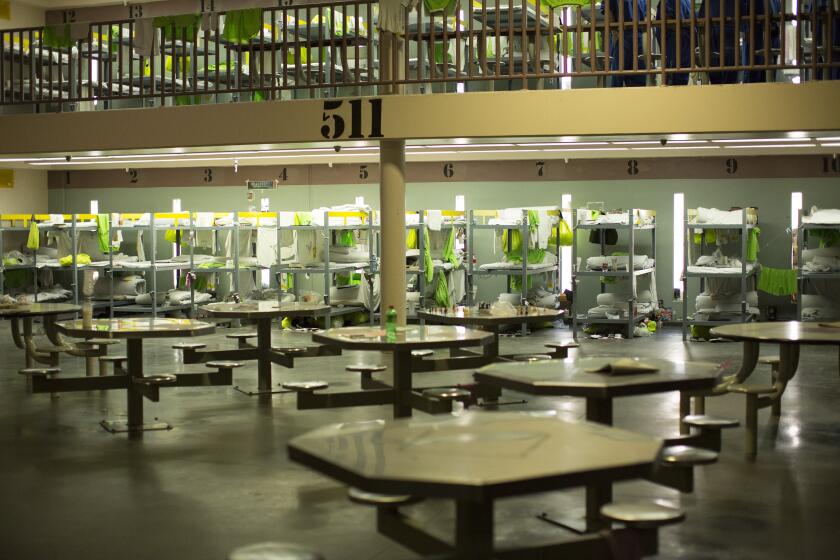L.A. has great weather, yet more homeless die of the cold here than in New York

- Share via
John D. Brider was found passed out near a homeless shelter and taken to Los Angeles County-USC Medical Center, where he later died.
Brider, 63, had gone into cardiac arrest and oxygen had been cut off to his brain. But another, seemingly improbable, factor contributed to his death last winter: hypothermia, or loss of body heat, from being out in the cold, the Los Angeles County coroner’s office ruled.
One of the abiding myths about Los Angeles is that homeless people come here from the East Coast or Midwest because at least they won’t freeze to death.
But despite L.A.’s typical sunshine and mild temperatures, five homeless people, including Brider, died of causes that included or were complicated by hypothermia in the county last year, surpassing San Francisco and New York City, which each reported two deaths. Over the last three years, 13 people have died at least partly because of the cold, the coroner’s office said. And advocates worry that this cold, rainy winter will mean more fatalities.
Hypothermia has led to more deaths in L.A. than in colder regions because 39,000 homeless people here live outdoors — by far the most of any metropolitan area in the country. L.A.’s generally moderate Mediterranean climate is no shield, because hypothermia can set in at temperatures as high as 50 degrees, experts say.
Going without a hat can drain up to half of a person’s body heat, and wet clothing can intensify heat loss twentyfold, according to a 2007 report from the National Health Care for the Homeless Council. Underlying medical conditions, alcohol and drug use — including the use of psychiatric medications — mental illness and the privations of living outdoors intensify the risk. Brider, for example, tested positive for cocaine and had cancer of the throat and tongue, the coroner said.
“Many people experiencing homelessness suffer from malnutrition and sleep deprivation, leading to some of them remaining out in the cold. Ultimately, sometimes they die,” said Bobby Watts, the homeless council’s chief executive.
L.A.’s hypothermia cases, first reported in the Capital & Main online publication, are a tiny fraction of the overall homeless death toll, which climbed from 720 in 2016 to 900 last year. But hypothermia is a particularly appalling , and preventable, way to die.
“The idea that people froze to death is really horrible; it is a shared societal tragedy,” said Jim O’Connell, founding director of the Boston Health Care for the Homeless Program, who researches hypothermia among homeless people.

A spokesman for Mayor Eric Garcetti said the city and county had added 1,607 new shelter beds in a year and expanded outreach. The county’s winter shelter program provides 1,200 extra beds from December to the end of March.
“The number of emergency beds for our homeless neighbors has increased each year for the last three years,” said spokesman Alex Comisar, “and we’re doing more outreach than ever before to bring people inside during inclement weather.”
But although most cold-exposure deaths occur in the winter, Mark Stuart, 56, died of probable hypothermia on a Long Beach embankment in April 2016 — after the winter shelters shut down. O’Connell says hypothermia is a particular risk when the temperature drops more than 10 degrees over the course of the day, a common phenomenon in L.A.
Jonathan E. Sherin, director of the Los Angeles County Department of Mental Health, says homeless people with severe and persistent mental illness are in jeopardy of hypothermia.
Over the last six to eight months, the county’s specialized Homeless Outreach Mobile Engagement teams, with 30 staff members supported by a psychiatrist, have fanned out to remote encampments to find homeless people who need help, he said.
“I wish it were happening more quickly,” said Sherin, who hopes to double staffing in the next year or so. “It’s our highest priority.”
Some homeless people perished from the cold in public view. A 44-year-old man sat outside a business for two nights in January 2018 before someone inside the building called 911, the coroner reported.
The man was taken to California Hospital Medical Center with a body temperature of 80.6 degrees and fed warm fluids. He died anyway.
Cold and rain are not the only weather conditions that are killing homeless people. The coroner reported six deaths in 2017 and 2018 involving hyperthermia, or abnormally high body temperatures, including three on the same sizzling hot day in July.
Michelle Marie Williams, 53, was found outside an apartment complex in Winnetka with an elevated alcohol level and a body temperature of 105.9 degrees. Williams’ forearm and thigh were burned, possibly by the sun, as she lay on the pavement for an undetermined period, the coroner said.
But with the persistent rain this winter, hypothermia is the immediate concern. Winter shelters, which usually close by day, stay open around the clock during heavy multi-day storms.
So on Wednesday, at the start of perhaps the biggest storm of the season, dozens of people milled around Hope for Home in Pomona, the county’s newest shelter.
The 16,000-square-foot fabric-shelter structure, which resembles a circus big top, hosts 200 winter-shelter and “crisis” clients a night, including disabled people, in cots and bunk beds. On Wednesday a young man on crutches gingerly picked his way through tightly spaced rows of cots, and a man with two prosthetic legs sat in a wheelchair.
The shelter is still under construction, but when it is finished, it will have medical, mental health and drug treatment facilities on site, so homeless people don’t have to run around for their appointments, director Reggie Clark said.Clark said his staff works to help clients overcome past experiences and challenges that have kept them out of shelters.
“They might have trouble following rules and regulations,” Clark said. “It’s all about how we treat people.”

Before the shelter opened in December, Glenn Oura, 55, of West Covina, was caught in a rainstorm while sleeping in the bushes outside a big-box store where he had a seasonal job.
“It was 40 degrees and the Santa Ana winds kicked up; I thought, ‘If I die from hypothermia, how long will it take someone to find me?’” said Oura, an appliance installer and U.S. Air Force veteran who said he became homeless in June after his rent and child support were raised.
Joey Robert Clayton, 54, also of West Covina, said he spent one recent night outside the shelter, beneath the overhang of the old Golden Ox, an abandoned fast-food restaurant in Pomona.
“I froze my butt off all night long,” said Clayton, a former house painter who said he worked as a concessions barker for Cirque du Soleil. “It was terrible.” He was back in the shelter the next day.
Oura plans to buy a truck and get his old job back, and Clayton, who suffers from seizures, wants to get on disability and move out. Until then, they are grateful for their beds, despite the noise, crowding and nighttime odors that come with living cheek by jowl with 200 people.
“It beats the alternative,” Oura said. “There’s still a lot of people a whole lot worse off.”
Twitter: @geholland
More to Read
Sign up for Essential California
The most important California stories and recommendations in your inbox every morning.
You may occasionally receive promotional content from the Los Angeles Times.











